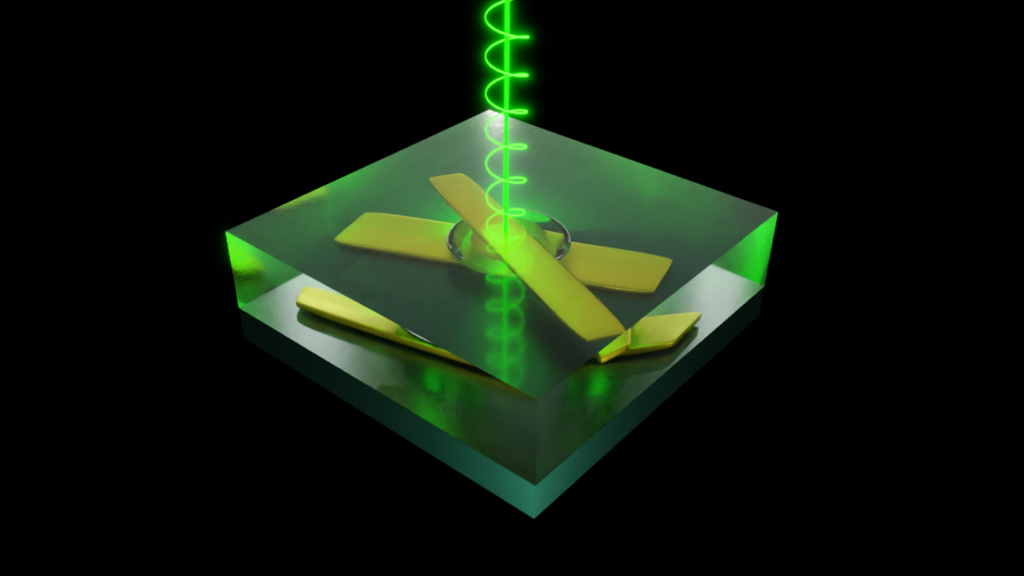Scientists conduct groundbreaking research in the field of nanophononics: Chiral Acoustoplasmonics. This cutting-edge technology harnesses the unique properties of plasmonic nanostructures to revolutionize the way we manipulate and control light and sound at the nanoscale.
Nanophononics, a rapidly developing field of nanotechnology, concerns the study of acoustic phonons – ultrahigh-frequency acoustic vibrations of atoms in a lattice – at the nanoscale. These waves modulate the physical properties of a solid-state system that depends on the relative position of the atoms, and therefore, they have strong interaction with other excitations such as electrons, photons and magnons. The engineering of acoustic phonons plays a fundamental role in numerous applications ranging from sensing to quantum technologies. One of the main challenges in the field is the lack of efficient transducers for the optimal control of acoustic phonons.
A group of researchers in an international collaboration between the Instituto de Micro y Nanotecnologia – IMN (Spain) and the Centre de Nanosciences et de Nanotechnologies – C2N (CNRS, Universite Paris-Saclay, France) led by Dr. Antonio García-Martín and Dr. Daniel Lanzillotti-Kimura, addressed this issue in a theoretical paper recently published in Nanophotonics, that proposes the use of plasmonic nanostructures presenting chiral properties for the enhancement of phonon generation and detection. “We are thrilled to introduce Chiral Acoustoplasmonics, a breakthrough technology that is simple and easy to fabricate, and merges chirality, acoustics, and plasmonics to unlock unprecedented control over nanoscale light and matter manipulation”, said Dr. Antonio García-Martín.
Chirality is a fundamental concept in chemistry and physics, that describes the asymmetry and distinct characteristics exhibited by certain molecules and objects that exist in two different enantiomeric forms, which are mirror images of each other but incapable of perfect alignment. Although the right- and left-handed forms of a chiral object typically have identical properties, their interactions with other chiral structures diverge. The researchers explore the interaction between the chirality of the light polarization – that can assume right- or left- circular polarization – and the chiral geometry of two twisted plasmonic nanobars embedded in silica, and theoretically propose a platform for efficient acoustic phonon transduction.
The incorporation of chirality into plasmonic nanostructures allows for unprecedented control over the absorption and scattering cross-sections, which are directly dependent on the circular polarization of incident light. Furthermore, in acoustoplasmonics experiments, the phonon generation relies on light absorption, whereas the phonon detection depends on light scattering. “The use of structures sustaining chiral optical modes appears as a natural, yet unexplored strategy to address these conditions”, remarked Dr. Lanzillotti-Kimura. “Thus, our proposed chiral system opens the way to enhanced and selective coherent phonon excitation and detection”, completes.
Chiral acoustoplasmonics serves as a fundamental building block for highly efficient phononic transducers. The potential applications of chiral acoustoplasmonics are vast and far-reaching. “We certainly believe that this technology not only expands the frontiers of nanophononics but also paves the way for groundbreaking advancements in fields such as sensing, communications, and quantum technologies”, said Daniel. “We could extend the use of chiral structures to quantum dot-based single-photon emitters where handedness could become a new design parameter”, completes.
Source: “Towards chiral acoustoplasmonics,” by Beatriz Castillo López de Larrinzar, Chushuang Xiang, Edson Rafael Cardozo de Oliveira, Norberto Daniel Lanzillotti-Kimura and Antonio García-Martín, Nanophotonics, 12, 1957 (2023).
The article can be accessed here.
